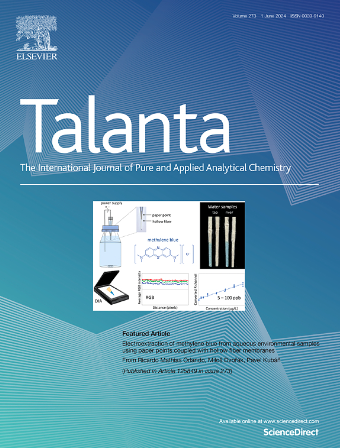Chromatographic separation and ecological risk assessment of pristine and functionalized fullerene nanomaterials in wastewater and sea water by UHPLC –UV–vis
IF 5.6
1区 化学
Q1 CHEMISTRY, ANALYTICAL
引用次数: 0
Abstract
The broad usage of fullerenes nanomaterials and their associated toxicity to non-target organisms makes them an emerging environmental concern. Standard analytical methods to monitor their occurrence in the environment are lacking due to their unique chemical structures, which results in acute hydrophobicity leading to poor chromatographic separation. However, their environmental presence and potential environmental risks necessitate for careful monitoring and risk assessment in wastewater treatment plants and aquatic environments. In this study, a chromatographic technique using an Ultra High-Performance Liquid Chromatography (UHPLC) coupled with UV–visible detector was used for the separation and quantification of fullerene nanomaterials in wastewater and seawater. The chromatographic separation method developed focused on C60 fullerene, C70 fullerene, [6, 6]-phenyl C61 butyric acid methyl ester (C61-PCBM) and [6,6]- Thienyl- C61- butyric acid methyl ester (C61-TCBM). High resolution transmission electron microscopy (HRTEM) and ultraviolet–visible spectroscopy were used to determine the size, shape and absorption wavelength of colloidal fullerene nanomaterials. This method was used for quantification of colloidal fullerene nanomaterials in a wastewater treatment plant and aquatic environments and wastewater treatment plants to assess their risk. The percentage recoveries of fullerene nanomaterials from wastewater, tap water and sea water were investigated for all fullerene nanomaterials C61-PCBM, C61-TCBM, C60 and C70 were 84 %–108 %, 83 %–108 %, 97 %–116 % and 62 %–115 %, respectively. The fullerene nanomaterials C61-PCBM, C61-TCBM and C60 had a linear range at concentrations of 0.25 μg L−1 to 50 μg L−1, with linear regression of 0.9968, 0.9959, 0.9991 and 0.9914, respectively. C70 show a linear range between 0.5 μg L−1 and 10 μg L−1, with linear regression of 0.9914. The limit of detection for C61-PCBM, C61-TCBM, C60, and C70 were 0.0663 μg L−1, 0.0262 μg L−1, 0.0370 μg L−1, and 0.0370 μg L−1, respectively. The developed method was applied to determine the selected fullerene nanomaterials in wastewater and sea water. Their concentrations in wastewater and sea water range from not detected to 2.73 μg L−1 and not detected to 2.05 μg L−1, respectively. The ecological risk assessment carried out on fullerene in the investigated media was found to have no risk to medium risk.

UHPLC -UV-vis对废水和海水中原始和功能化富勒烯纳米材料的色谱分离及生态风险评价
富勒烯纳米材料的广泛应用及其对非靶生物的毒性使其成为一个新兴的环境问题。由于其独特的化学结构,导致其急性疏水性导致色谱分离效果差,因此缺乏监测其在环境中发生的标准分析方法。然而,它们的环境存在和潜在的环境风险需要在污水处理厂和水生环境中进行仔细的监测和风险评估。本研究采用超高效液相色谱(UHPLC) -紫外可见检测器对废水和海水中的富勒烯纳米材料进行分离和定量。建立了C60富勒烯、C70富勒烯、[6,6]-苯基C61丁酸甲酯(C61- pcbm)和[6,6]-噻吩- C61-丁酸甲酯(C61- tcbm)的色谱分离方法。采用高分辨率透射电子显微镜(HRTEM)和紫外可见光谱法测定了胶体富勒烯纳米材料的尺寸、形状和吸收波长。采用该方法对某污水处理厂、水生环境和污水处理厂中胶体富勒烯纳米材料进行定量分析,评估其风险。研究了废水、自来水和海水中富勒烯纳米材料的回收率,其中C61-PCBM、C61-TCBM、C60和C70的回收率分别为84% ~ 108%、83% ~ 108%、97% ~ 116%和62% ~ 115%。富勒烯纳米材料C61-PCBM、C61-TCBM和C60在0.25 ~ 50 μg L−1浓度范围内线性回归,线性回归分别为0.9968、0.9959、0.9991和0.9914。C70在0.5 μg L−1 ~ 10 μg L−1之间呈线性变化,线性回归为0.9914。C61-PCBM、C61-TCBM、C60和C70的检出限分别为0.0663 μg L−1、0.0262 μg L−1、0.0370 μg L−1和0.0370 μg L−1。将所建立的方法应用于废水和海水中富勒烯纳米材料的测定。它们在废水和海水中的浓度范围分别为未检出至2.73 μg L−1和未检出至2.05 μg L−1。对调查介质中的富勒烯进行了生态风险评价,发现其无风险至中度风险。
本文章由计算机程序翻译,如有差异,请以英文原文为准。
求助全文
约1分钟内获得全文
求助全文
来源期刊

Talanta
化学-分析化学
CiteScore
12.30
自引率
4.90%
发文量
861
审稿时长
29 days
期刊介绍:
Talanta provides a forum for the publication of original research papers, short communications, and critical reviews in all branches of pure and applied analytical chemistry. Papers are evaluated based on established guidelines, including the fundamental nature of the study, scientific novelty, substantial improvement or advantage over existing technology or methods, and demonstrated analytical applicability. Original research papers on fundamental studies, and on novel sensor and instrumentation developments, are encouraged. Novel or improved applications in areas such as clinical and biological chemistry, environmental analysis, geochemistry, materials science and engineering, and analytical platforms for omics development are welcome.
Analytical performance of methods should be determined, including interference and matrix effects, and methods should be validated by comparison with a standard method, or analysis of a certified reference material. Simple spiking recoveries may not be sufficient. The developed method should especially comprise information on selectivity, sensitivity, detection limits, accuracy, and reliability. However, applying official validation or robustness studies to a routine method or technique does not necessarily constitute novelty. Proper statistical treatment of the data should be provided. Relevant literature should be cited, including related publications by the authors, and authors should discuss how their proposed methodology compares with previously reported methods.
 求助内容:
求助内容: 应助结果提醒方式:
应助结果提醒方式:


